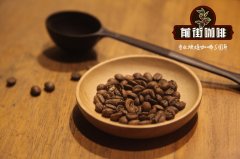What are the recommendations for cost-effective espresso beans? Where can I find a good espresso bean?

Professional coffee knowledge exchange More coffee bean information Please pay attention to coffee workshop (Weixin Official Accounts cafe_style)
Espresso coffee originated in Italy, in Italian means "very fast", through the pressure of steam, instant coffee liquid extraction. Because this practice can last for a long time coffee fat, taste mellow thick, sour and bitter balance, so it is called coffee art. Espresso is also often used as the basis for other coffee types, such as latte, cappuccino, macchiato, and mocha, all of which are espresso based.
Italian Coffee Bean Selection:
Espresso coffee is a blend of coffee beans, such as Kenya, mantinin, mocha, Brazil, Colombia, etc. are often used as a base bean blend. Different varieties of beans from different places, plus the acquired baking time, naturally have a unique taste and aroma after mixing. Coffee beans are selected mainly according to whether the taste after extraction meets personal preferences.
Brewing espresso at home: From coffee beans to coffee machines
1. Kenya
Coffee beans have obvious fruit acid flavor and hard texture, among which coffee beans with blackberry flavor are regarded as the best. The quality and productivity of coffee beans from small farms are far better than those of large farms, and the quality of large farms can only be classified as medium. Kenya beans are divided into seven grades according to particle size and appearance, the highest grade is AA or AA+, followed by AB, PB, C, E, TT, T, but the appearance is not directly proportional to the taste.
2. Colombia
Arabica varieties, coffee thickness is neutral, roasted with sweet, sour taste with a strong sweet, slightly bitter, often used in mixed coffee, such as sweet potato skin flavor is the most advanced varieties.
3. Mandheling
Sumatra, Indonesia. It is a base bean with bitter roast taste, thick and strong taste. It is the most commonly mixed coffee bean.
4. mocha
For example, mocha produced in Ethiopia in Africa belongs to Arabica varieties, with unique sweet and sour taste charming, but also with the special taste of chocolate, baking with fruit, such as mixing in coffee can increase aroma, mellow taste more unique.
5. Brazil
It is Arabica, which tastes slightly sour, slightly sweet, slightly bitter and has a light aroma. It belongs to coffee beans with neutral taste and has no strong special taste. It is very suitable for drinking as a single product or mixing with other coffees.
Developing a blended coffee bean is actually more complicated, longer and more time-consuming than a single bean. We know that single coffee as long as the roast of this bean origin flavor, then it is a good bean, most beans as long as you roast without major mistakes, use light roast and then use the way of hand coffee can actually show the flavor of this bean
To develop a blend, you have to know the beans from all major producing areas very well. For example, you can't find beans from the same producing area that are processed in the same way to make a blend. For example, if you use Kocher of yejia sherphine and Bank of yejia sherphine to make a blend, then it doesn't make much sense, because the beans that are blended together still show floral citrus tonality, and this blend bean must be a bean with insufficient maturity. Wouldn't it be better to mix a Central American Guatemala or Costa Rica with washed yeja coffee? So first of all, you have to have an understanding of the beans in each major producing area, the specific trend of flavor, and then these beans are combined together, what can be obtained, whether they can make up for the shortcomings, or whether they will produce new flavors.
Testing a blending cycle will also be longer, we know that blending beans need to grow beans, generally 7-10 days, we generally bake good from the fifth day of testing, testing has been to find his best growing period
Second, the ratio of blending, for example, with two beans, is it 3:7 or 4:6, or 5:5? If you are using three kinds of beans, then the proportion of the mixture will be more complicated, these are based on your usual understanding of raw beans, combined with baking experience to judge.
I usually develop new blends. I will bake samples in a small pot oven first, which saves the cost of beans. After determining the proportion and baking degree of the blends, I will use a large baking machine to replicate the baking curve. The development time will take about a month. And I would choose the same brand of roaster, so that the baking curve is easier to copy and less prone to errors.
So I think a balanced, sweet blend is a good bean.
The American coffee with the extra good fat doesn't mean the coffee is good. If you put more than 50% Robusta beans in your blend, the fat will be excellent, but the taste will be too boring.
So a bean I suggest should be the choice of Arabica coffee beans, Robusta coffee beans can not exceed 20%, roast degree as far as possible do not choose black oily beans, roast black oily beans is to cover up the poor quality of beans and defective flavor, because oily beans left only bitter, no other flavor, including good and bad flavor. To buy freshly roasted coffee beans, coffee beans also have a shelf life, and the flavor of blended coffee beans begins to decline one month after roasting
Cost-effective Italian coffee beans recommended:
There are still some small studios in China that bake beans well, but they can't be stable and sustainable.
At present, there are relatively good decimals, micro-baked, front street, M2M and so on
If you like a more stable and authentic mix, you can buy some big Italian brands, Iily, Esther, Lavasa.
Important Notice :
前街咖啡 FrontStreet Coffee has moved to new addredd:
FrontStreet Coffee Address: 315,Donghua East Road,GuangZhou
Tel:020 38364473
- Prev

How should coffee rookies choose coffee beans? What are the misunderstandings when buying coffee beans?
Professional coffee knowledge exchange more coffee bean information please pay attention to the coffee workshop (Wechat official account cafe_style) how to select good coffee beans in fact, the problem is generally divided into two aspects, on the one hand, selecting raw beans; on the other hand, selecting cooked beans. Today we won't talk about raw beans, because many friends don't talk about baking. Let's teach you how to choose to be familiar.
- Next

What kind of beans are better for making Italian style with automatic Coffee Machine? is it strange to use single beans to make Italian style?
Professional coffee knowledge exchange more coffee bean information Please follow the coffee workshop (Wechat official account cafe_style) automatic coffee machine with Italian coffee beans choose to advise me to drink coffee for so many years, no matter how good and stable the quality of a shop is, I will never buy coffee beans in a store, because each roaster has a different style, just like the chef's craftsmanship.
Related
- Guji coffee producing area of Guji, Ethiopia: Humbela, Shakiso, Wulaga
- What is the most expensive variety of Qiloso in BOP multi-variety group?
- How to store the coffee beans bought home?
- Why are Yemeni coffee beans so rare now?
- Ethiopian Sidamo all Red Fruit Sun Sun Santa Vini Coffee beans
- SOE is mostly sour? What does it mean? Is it a single bean? what's the difference between it and Italian blending?
- Is Italian coffee beans suitable for making hand-brewed coffee?
- How to choose coffee beans when making cold coffee? What kind of coffee beans are suitable for making cold coffee?
- Just entered the pit to make coffee, what kind of coffee beans should be chosen?
- Can only Japan buy real Blue Mountain Coffee? What are authentic Jamaican Blue Mountain coffee beans?

